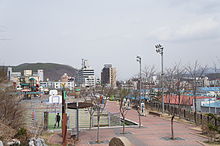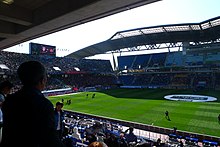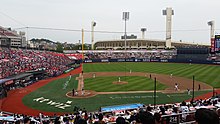Gyeonggi Province
[citation needed] Gyeonggi Province has been a politically important area since 18 BCE, when Korea was divided into three nations during the Three Kingdoms period.Gyeonggi Province is in the western central region of the Korean Peninsula, which is vertically situated in Northeast Asia and is between east longitude of 126 and 127, and north latitude of 36 and 38.The topography of Gyeonggi Province is divided into southern and northern areas by the Han River, which flows from east to west.Besides the listed, the scenery of well-known mountains including Soyosan of Dongducheon City, Yongmunsan of Yangpyeong County, and Gwanaksan of Anyang and Gwacheon, along with Hangang and Imjingang are tourist sites of Gyeonggi Province.Gyeonggi Province's proximity to Seoul, South Korea's capital, and Incheon, its second-busiest port, has contributed to its extremely well-developed transportation infrastructure.The area has access to many of South Korea's expressways, including Gyeonggi Province is served by Korail commuter, standard and high-speed (KTX) services.Gyeonggi has stations on the Suin, Bundang, Gyeongchun, and Shinbundang commuter rail services and the Gyeongbu and Honam High Speed Railways.Line 1 (formerly Korea National Railroad of Seoul) extends to Cheonan past Gyeonggi Province to the southwest, and to Dongducheon to the north.A short section of the AREX line between Gimpo and Incheon airports passes through Gyeonggi, but there are no stops within the province.Gyeonggi Province is actively investing in education to foster a talented population suitable for the globalized economy.It is promoting the opening of local campuses of reputable universities as well as establishing special purpose high schools for high-quality education.For castles (called seong), there are Suwon Hwaseong, which is designated as the World Cultural Heritage, Namwonsanseong, Haengjusanseong, Ganghwasanseong, and Doksan Fortress.Gyeonggi Province is investing a lot of money at a provincial level so that people do not have to go to Seoul to enjoy a high-class cultural life.As for the professional soccer teams with Gyeonggi Province as their home ground, there are the Suwon Samsung Bluewings and Seongnam FC.[22][18] Other birds in Gyeonggi Province include the common sandpiper, long-toed stint, wood sandpiper, ring-necked pheasant, white-winged tern, Oriental turtle dove, rock dove, Oriental dollarbird, common kingfisher, common hoopoe great spotted woodpecker, grey-headed woodpecker Japanese pygmy woodpecker, black-naped oriole, Eurasian skylark, brown-eared bulbul, long-tailed tit, Oriental reed warbler, vinous-throated parrotbill, white-cheeked starling, dusky thrush, Asian brown flycatcher, Daurian redstart, Eurasian tree sparrow, brambling, and Oriental greenfinch.[18] Butterflies in the province include the Asian comma, common straight swift, lesser purple emperor, painted lady, pale grass blue, Pallas' sailer, red ring skirt, small white, and Colias poliographus.[18] The province's damselflies and dragonflies include the common bluetail, Ischnura asiatica, Platycnemis phyllopoda, blue-spotted emperor foot-tipped darter, regal pond cruiser, white-tailed skimmer, Deielia phaon, and Sympetrum infuscatum.[18] The province's lakes and streams house Amur catfish, Eurasian carp, largemouth bass, northern snakehead, and pale chub.



Gyeonggi (region)ProvinceHangulSeongnamIcheonSiheungGwangmyeongYonginCountrySouth KoreaRegionSeoul Metropolitan AreaCapitalGovernorKim Dong-yeonDemocraticForsythiaGinkgoISO 3166 codeGyeonggiKoreanprovincial-level special cityIncheonprovincial-level metropolitan citySudogwonThree KingdomsKing OnjoBaekjeWiryeseongHan River ValleyGoguryeoKing JinheungLater SillaGoryeoKing Taejo of GoryeoKing HyeonjongJoseonKing Taejo of JoseonSejong the GreatChungjuGongjuKaesongJapanese colonial periodNorth Korean38th parallelNorth Hwanghae ProvinceOngjin CountyGanghwa CountyGangwon ProvinceNorth Chungcheong ProvinceSouth Chungcheong Provincenorthern regionPyeongtaeksouthernnorthern areasHan RiverGwangjuMyeongjisanBukhansan National ParkYeoninsanYangpyeong CountyGwanaksanAnyangGwacheonMoraksanGoyangHwasungBucheonYeoncheon CountyGapyeong Countyheavy industrylight industrysmall and medium-sized enterprisesU-JIN Tech Corp.Samsung ElectronicsSK HynixSamsung SDIPaju LG Corporation's LCD complexList of cities and counties of Gyeonggi ProvinceSpecial CityNamyangjuHwaseongUijeongbuYangjuAnseongUiwangPocheonDongducheonCountyYangpyeongGapyeongYeoncheonCommittee for the Five Northern Korean ProvincesGaeseongGaepung CountyJangdan CountyIncheon International AirportGimpo International AirportSouth Korea's expresswaysGyeongbu ExpresswaySeohaean ExpresswayJungbu ExpresswayTongyeongSecond Jungbu ExpresswayJungbu Naeryuk ExpresswayChangwonYeongdong ExpresswayGangneungSeoul–Yangyang ExpresswayChuncheonSeoul Ring ExpresswaySecond Gyeongin ExpresswayGyeongin ExpresswayIncheon International Airport ExpresswayKorailGyeongin LineGTX-A LineGyeongbu LineGyeongui LineJungang LineHonam LineBundangGyeongchunShinbundangcommuter railGyeongbu

